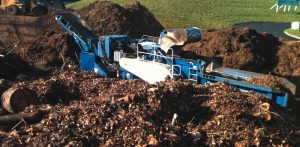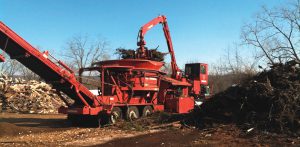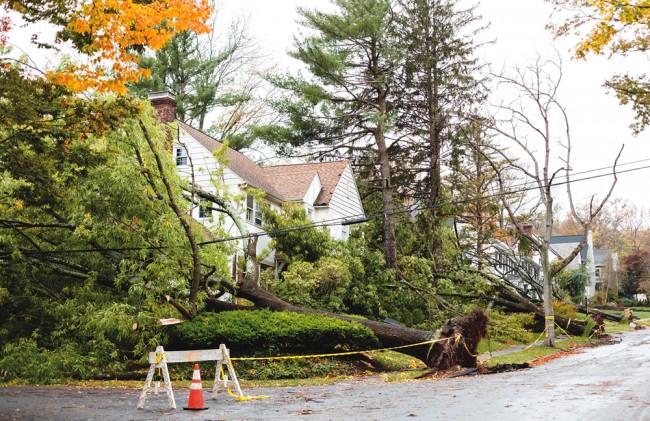Municipalities and private contractors in New Jersey and Connecticut are grinding their way through the whole trees and roots uprooted by the October hurricane.
Diane Greer and Nora Goldstein
BioCycle January 2013, Vol. 54, No. 1, p. 42
“Everything that came down was big,” says Kevin Downes, owner of Downes Services in Hawthorne, New Jersey. “Whole root balls just came out of the ground. It was five times as bad as last year’s Halloween snowstorm that damaged about 75 percent of the trees in our area.”
Since Superstorm Sandy, Downes’ company has been collecting debris off the streets for many municipalities. “It is a challenge,” he says. “So much more time and equipment is needed to deal with each of these big trees. It takes days and a tremendous number of man hours to take trees off houses and power lines and then deal with the stumps.” To manage the huge volumes of debris, material is hauled to the municipalities’ recycling centers where it is ground and made into a finished landscaping product that will be given away to town residents next spring. “There is just no place to go with it,” Downes adds. In one town, it has been working on removing the stumps of 188 uprooted trees. “It is a big process that does not happen very quickly,” he explains. “ We are estimating at least 4 to 6 months more worth of work.”
Downes Services operates its own recycling center in Hawthorne, where it processes tree debris into mulch products. Normally the company sells about 100,000 yards of mulch a year. “This year we will probably double that because of the volume of material from the storm,” Downes notes. The company uses two Diamond Z grinders, a Model 1360 tub grinder and a Model 5000 horizontal grinder, to process the debris at its own site, and the other locations. The equipment has been running 10 to 12 hours a day. “The grinders do a really nice job,” he says.

South Jersey Agricultural Products has been processing tons of debris left behind by Superstorm Sandy. It uses a track-mounted Peterson horizontal grinder.
SJAP has a bagging facility at its yard in Elmer, where it packages mulch, colored mulch, topsoil and other products for brokers who supply the big box stores. It sells some products under its own brand. “This is the time of year we are very busy filling bags for the spring season, so having this flow of mulch was good timing for us,” adds Stella. The company uses Colorbiotics’ Sahara colorizing equipment. “Between the topsoil, colored mulch and straight mulch, we supply several million bags a year to the brokers and our own network,” he says.
Harvest Power, which has 11 sites in New Jersey, is also processing tree debris from Superstorm Sandy. The material is ground, stockpiled and aged to make mulches and composted soil products. “This was a massive storm that caused a lot of damage,” says Paul Sellew, Harvest Power CEO. The company has brought in extra grinders and loaders and has been grinding material nonstop since the winds died down. It has been working with certified contractors from outside the region to deal with the staggering number of trees.
Wood reaching its facilities is checked to determine the quality and type of material. Almost everything is getting ground. Best efforts are made to process the material and turn it back around for sale, or store it for the spring season. Harvest Power anticipates a lot of people will want to restore their landscapes come spring, creating demand for additional loads of its mulches and soil products. Everyone is working extra hard to deal with permit caps and occasional space constraints. In some cases, sites that are not logistically close to the damaged areas will be needed to hold the material.
Harvest Power recently purchased GreenCycle’s composting and mulch facilities in Connecticut (three in total). Its operation in Fairfield is close to the shoreline, which was pretty heavily hit by Superstorm Sandy. “We received an extra 5,000 tons of wood debris just from one town,” says James Repenning of GreenCycle/Harvest New England. “We also have been bringing our grinding equipment to towns along the shoreline. In most cases we’ve been able to use their existing recycling yards to process the material.”

GreenCycle purchased a mobile Morbark tub grinder that could handle the large oversized material and trunks. Since Sandy hit, it has been transporting the grinder to municipalities’ recycling yards, such as the Town of Ellington, Connecticut, where it can utilize the Town’s loaders and operators.











